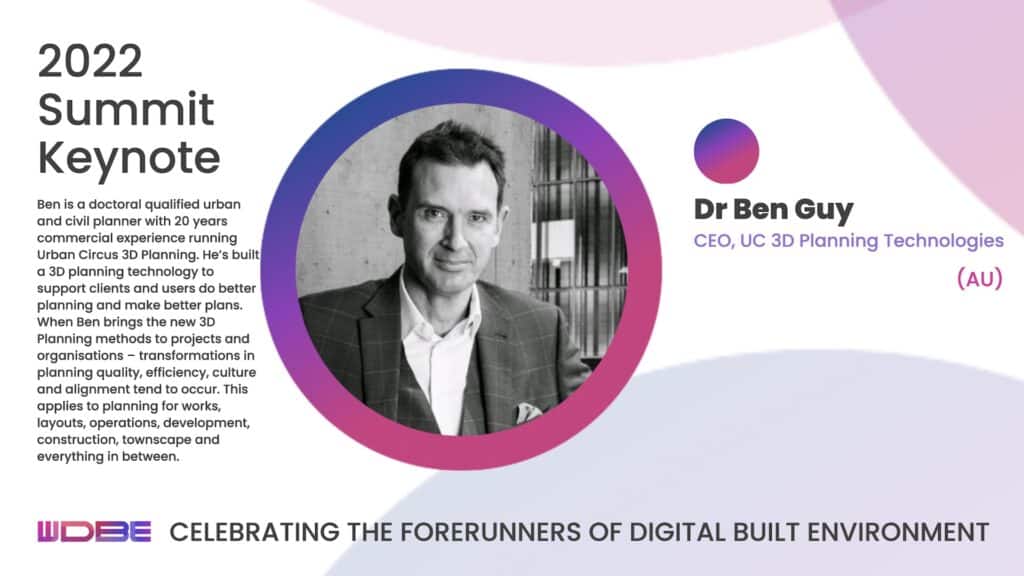The evolution of digital 3D visualization is allowing everyone to experience and participate in urban planning in unprecedented ways. That’s the topic of Aarni Heiskanen’s interview with Dr. Ben Guy, head of Urban Circus and a keynote speaker at the WDBE.
”Communication is everything,” argues Ben. “Communication happens every day, and it can make or break a project.”
His company, Urban Circus, is a 20-year-old Australian family-owned business specializing in 3D communication in the built environment. Their work includes videos, stories, VR, AR, interactive models, gamification, simulations, and planning workflows.
One of their most notable clients to date was the premier of Victoria, the southeastern state of Australia. Urban Circus acted as the premier’s team’s behind-the-scenes specialist for turning their every plan or dream into a 3D model, usually overnight! Ben says they could achieve this because they have a massive 3D model of the urban area at their disposal.
“So now what we have is an empowered client who’s not so dependent on large civil engineering and architectural firms having all the power,” he points out. “That did him very well on Facebook and other things like that back in the day…We even made him into a bit of a superstar!”
From attic artistry to urban planning
Ben started his exploration of visual communication in his mother’s attic during his teenage years. At the top of the house, there was a viewing platform called widow’s walk, which provided him with a convenient space for various artistic activities, like screen printing and airbrushing.
Ultimately, Ben did not choose an artist career but instead studied math and physics. However, he complemented his core curriculum with an urban regional planning degree in the tropics of Australia. One of his memorable projects involved importing a rhinoceros to the country for ecological conservation purposes.
Due to a family tragedy, Ben moved to the UK, which is where he did his Ph.D. Here, he focused on character, morphology, and place – ideas of bringing a human scale to city planning. He had observed in the east of England how post-war modernist reconstruction was the opposite of just that, with many great roads developed but no place-making.
“When I came back to Australia, I found there’s a lot of infrastructure work, and a lot of the civil engineering companies were making exactly the same mistakes that they had made in post-war reconstruction with big infrastructure, big pillars, and an inhuman scale,” Ben recalls.
Harnessing technology to create better environments
In the early 2000s, SketchUp, a new 3D creation software, came around and revolutionized the industry. It allowed the rapid 3D modeling of buildings and infrastructure. It also made exploring the virtual environments easy. Up till then, modeling software had been either very costly or cumbersome to use for urban designers.
Ben admits that the emergence of SketchUp sparked off his 3D business, Urban Circus.
One of the company’s early projects involved the city of Brisbane. Ben realized the opportunities of a city model and offered to provide it for free to the planners. After much manual work, the model was completed, but, to his dismay, the client did not appreciate the effort.
Funnily enough, Ben is now releasing an updated version of Brisbane that is much bigger and more detailed, thanks to photogrammetry. With this update, you can drag and drop objects, move them around, and explore various design scenarios within the model.
Toward technology egalitarianism
3D technology has come on leaps and bounds since the turn of the century. Thanks to lidars and software that can quickly handle large quantities of data, centimeter accuracy in city models is now a reality. Also, BIM and scanned models can live side by side in a 3D environment. And gaming engines, like Unreal Engine and Unity, enable real-time planning and visualization.
Ben thinks the evolution of technology is democratizing the design field. Access to data and powerful tools is no longer a privilege of the large firms. Anybody with a modern iPhone already has a lidar in their pocket. In addition, many cities have started offering developers 3D and other data types for free or at a reasonable price.
Affordable technology and data together are giving rise to new business models, as you can see, for example, in the Nordics.
Virtual or real reality?
Ben does not use VR habitually, and neither do the technologists he employs.
In general, VR has not really taken off yet. Some companies are touting the metaverse, specifically a VR version, as the next step in the internet’s evolution. However, Ben sees this mainly as a new way to make money for these businesses.
“I’m pretty environmental in my ethos that I want to use technology to make the real world better, rather than use technology to maybe take me away from the real world,” he says.
The exponential technological development we’ve seen in the last decades may make VR and AR popular, further blurring the lines between illusion and reality. The first iPhone came out in 2007 and is now on a completely different level than it was 13 years ago, Ben reminds.
To PowerPoint-level 3D
Ben’s vision is to make good places more easily. His clients have already enjoyed more intelligent planning and better city outcomes than would have been possible with traditional methods. But there are also other, sometimes surprising, uses for realistic 3D.
For example, one of Urban Circus’ clients modeled a train explosion in a virtual tunnel to plan emergency evacuations. Accurate 3D data can also help in court, as another client discovered. You can’t argue with trigonometry, as Ben puts it.
Urban Circus’s next endeavor is to make urban 3D planning as easy as PowerPoint. In that way, everyone involved in planning or construction can use interactive 3D in their business.
“Everybody can use PowerPoint, even my mom, my dear mother; I can use PowerPoint to make polygons and stars and shapes. So that’s where we’re going,” Ben says. “We’re democratizing that right down to the guys on site. So we’ll show that it’s a lot of fun.”
You can learn more about Ben’s thoughts and experience his visual wizardry at the WDBE on September 28, 2022. Register now at wdbe.org.
Listen to the whole interview on WDBE Talks.


